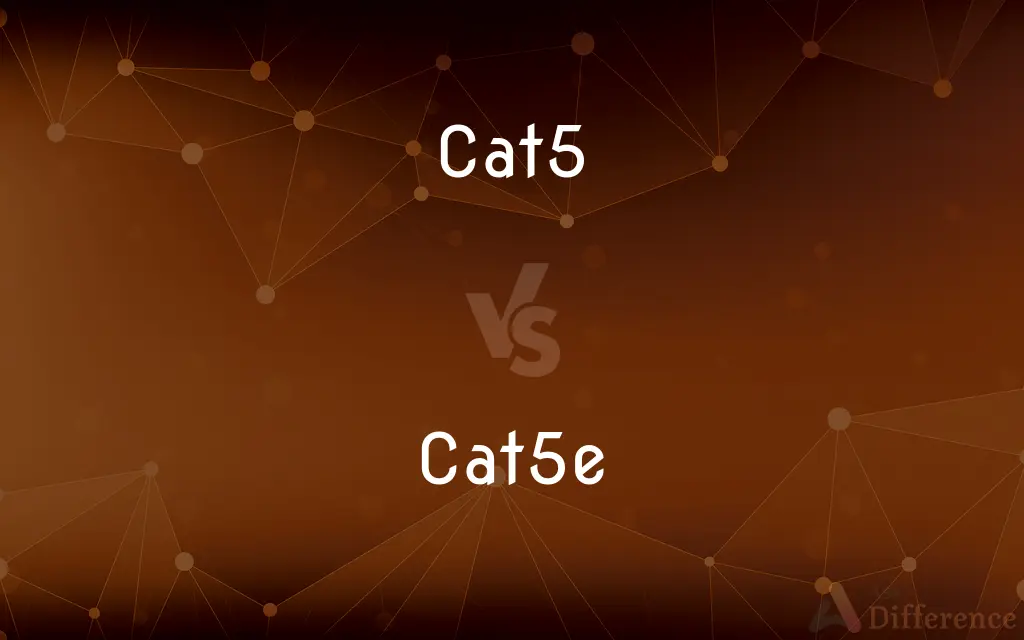Cat5 vs. Cat5e — What's the Difference?
By Tayyaba Rehman — Published on December 3, 2023
Cat5 (Category 5) is an older Ethernet cable standard, while Cat5e (Category 5 Enhanced) is an improved version with better performance and reduced crosstalk.

Difference Between Cat5 and Cat5e
Table of Contents
ADVERTISEMENT
Key Differences
Cat5 and Cat5e are both standards for twisted-pair cables used in Ethernet and other network physical layers. These cables, essential for wired networking, exhibit subtle but significant differences that influence their performance.
Cat5, once a standard for most networking tasks, was designed to support data transfer at rates up to 100 Mbps. Cat5e, on the other hand, emerged as a response to the increasing demand for higher data rates and more reliable connections. It not only supports speeds up to 1 Gbps but also has the capability to maintain these speeds over longer distances.
The “e” in Cat5e stands for "Enhanced." This enhancement primarily pertains to the cable's capability to limit "crosstalk." In Cat5 cables, signals from one wire might interfere with another, leading to diminished data integrity. Cat5e, with its improved design, effectively reduces this crosstalk, ensuring a clearer signal path and better data transmission.
When considering durability and longevity, both Cat5 and Cat5e cables might seem similar. However, because the Cat5e cables are designed to support faster and more reliable networks, they have become the default choice for modern installations. While you might still encounter Cat5 in older setups, most contemporary networks prefer the enhanced capabilities of Cat5e.
While both Cat5 and Cat5e cables can be used for a range of applications including Ethernet over twisted pair, Cat5e's improved specifications make it a more suitable choice for environments demanding higher data rate transmissions and reduced interference.
ADVERTISEMENT
Comparison Chart
Maximum Data Rate
100 Mbps
1 Gbps
Design Purpose
Standard networking
Enhanced performance & reduced crosstalk
Crosstalk Resistance
Standard
Improved
Common Use
Older networks
Modern networks
Standardization Year
Mid 1990s
2001
Compare with Definitions
Cat5
Often used in 10/100 Mbps networks.
The company's legacy systems were all connected via Cat5.
Cat5e
Suitable for networks up to 1 Gbps.
For the new gigabit network, Cat5e was the minimum requirement.
Cat5
Supports data transfer rates up to 100 Mbps.
For basic internet browsing, the Cat5 cable sufficed.
Cat5e
Provides clearer signal paths and better data transmission.
To enhance our video conferencing quality, we switched to Cat5e.
Cat5
Features standard crosstalk resistance.
To avoid interference, the technician recommended moving away from Cat5.
Cat5e
An enhanced version of Cat5 cabling.
The new office was wired with Cat5e to ensure better connectivity.
Cat5
A standard for twisted-pair network cables.
The office's old network infrastructure was based on Cat5 cabling.
Cat5e
Designed to reduce crosstalk and support higher data rates.
With Cat5e, our network achieved speeds close to 1 Gbps.
Cat5
Predecessor to the enhanced Cat5e standard.
We upgraded from Cat5 to ensure faster network speeds.
Cat5e
Became the default choice for modern Ethernet installations.
All recent residential setups I've seen have Cat5e cabling.
Common Curiosities
Can Cat5e cables be used as a direct replacement for Cat5?
Yes, Cat5e can replace Cat5 and will often provide better performance.
What does the “e” in Cat5e stand for?
The “e” stands for "Enhanced."
Which is better for a gigabit network, Cat5 or Cat5e?
Cat5e is better suited for gigabit networks due to its higher data rate support.
Are Cat5 cables still in production?
While Cat5e has largely replaced Cat5, some manufacturers might still produce Cat5 for specific scenarios.
Does the length of the cable affect performance in Cat5e?
Yes, longer lengths can reduce performance, but Cat5e maintains better performance over distance compared to Cat5.
Do both Cat5 and Cat5e cables look the same externally?
Externally, they can look similar, but differences lie in internal design and performance.
Are connectors for Cat5 and Cat5e the same?
Both use RJ45 connectors, making them interchangeable.
Can Cat5 support 1 Gbps speed?
Cat5 is not designed for 1 Gbps; Cat5e is.
Can I mix Cat5 and Cat5e in a network?
While they can be mixed, it's best to stick with Cat5e for consistent performance.
How do I identify if a cable is Cat5 or Cat5e?
The cable's jacket usually has markings indicating its category.
Why is crosstalk a concern in networking cables?
Crosstalk can cause interference, leading to reduced data integrity and speed.
Which is more expensive, Cat5 or Cat5e?
Prices can vary, but Cat5e might be slightly more expensive due to its enhanced features.
When was Cat5e introduced?
Cat5e was standardized around 2001.
Is Cat5e future-proof for upcoming network standards?
Cat5e supports up to 1 Gbps, but for higher future standards, Cat6 or above would be recommended.
Do Cat5 and Cat5e have the same color-coded wiring?
Generally, yes. Both follow similar color-coded wiring schemes for Ethernet.
Share Your Discovery

Previous Comparison
HDPE vs. LDPE
Next Comparison
Anil Ambani vs. Mukesh AmbaniAuthor Spotlight
Written by
Tayyaba RehmanTayyaba Rehman is a distinguished writer, currently serving as a primary contributor to askdifference.com. As a researcher in semantics and etymology, Tayyaba's passion for the complexity of languages and their distinctions has found a perfect home on the platform. Tayyaba delves into the intricacies of language, distinguishing between commonly confused words and phrases, thereby providing clarity for readers worldwide.
















































